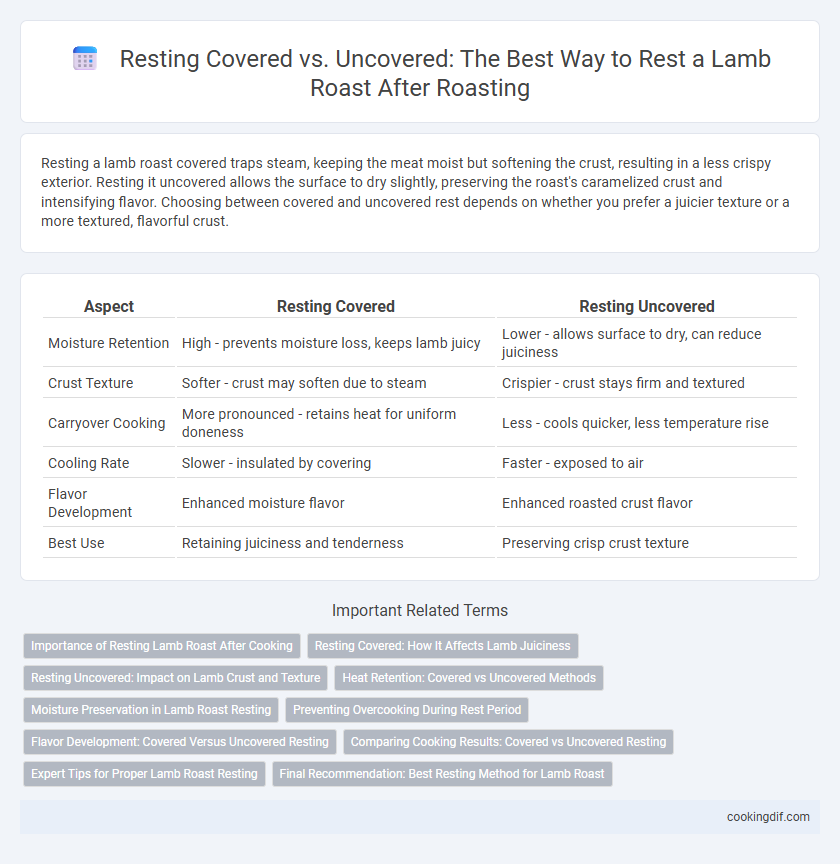Resting a lamb roast covered traps steam, keeping the meat moist but softening the crust, resulting in a less crispy exterior. Resting it uncovered allows the surface to dry slightly, preserving the roast's caramelized crust and intensifying flavor. Choosing between covered and uncovered rest depends on whether you prefer a juicier texture or a more textured, flavorful crust.
Table of Comparison
| Aspect | Resting Covered | Resting Uncovered |
|---|---|---|
| Moisture Retention | High - prevents moisture loss, keeps lamb juicy | Lower - allows surface to dry, can reduce juiciness |
| Crust Texture | Softer - crust may soften due to steam | Crispier - crust stays firm and textured |
| Carryover Cooking | More pronounced - retains heat for uniform doneness | Less - cools quicker, less temperature rise |
| Cooling Rate | Slower - insulated by covering | Faster - exposed to air |
| Flavor Development | Enhanced moisture flavor | Enhanced roasted crust flavor |
| Best Use | Retaining juiciness and tenderness | Preserving crisp crust texture |
Importance of Resting Lamb Roast After Cooking
Resting lamb roast after cooking allows juices to redistribute, resulting in a more tender and flavorful meat. Covering the roast with foil while resting helps retain heat and moisture, preventing the lamb from drying out. Resting uncovered may cause the lamb to cool too quickly, leading to a less juicy and less succulent final dish.
Resting Covered: How It Affects Lamb Juiciness
Resting lamb roast covered traps steam, which helps redistribute moisture and enhances juiciness throughout the meat. Covering the lamb with foil or a lid prevents heat loss, promoting even internal temperature and tender texture. This method retains succulent flavors by minimizing moisture evaporation during the crucial resting phase.
Resting Uncovered: Impact on Lamb Crust and Texture
Resting lamb roast uncovered allows moisture to evaporate, resulting in a firmer, crisper crust that enhances the overall texture. This method helps maintain the roast's savory, caramelized exterior while preventing sogginess often caused by trapped steam when covered. Uncovered resting is ideal for those seeking a balance between juicy meat and a golden, crunchy bark on their lamb roast.
Heat Retention: Covered vs Uncovered Methods
Resting lamb roast covered helps retain heat more effectively by trapping steam, which maintains higher internal temperatures and ensures juicier meat. Resting uncovered allows heat to dissipate quickly, leading to faster cooling but also promoting a firmer crust. Choosing covered resting maximizes heat retention, preserving tenderness and moisture crucial for optimal lamb roast texture.
Moisture Preservation in Lamb Roast Resting
Resting a lamb roast covered retains moisture by trapping steam, which prevents evaporation and keeps the meat succulent. Uncovered resting allows the surface to cool and dry, potentially forming a crust that reduces juiciness in the outer layers. For optimal moisture preservation, resting covered is preferred, especially when aiming for a tender and juicy lamb roast.
Preventing Overcooking During Rest Period
Resting a lamb roast covered with foil helps retain heat and moisture, preventing the meat from drying out while ensuring even temperature distribution. Uncovered resting promotes a crusty exterior but risks heat loss that can lead to the roast overcooking as residual heat continues to cook the lamb. Controlling resting conditions balances carryover cooking and moisture retention, critical for achieving optimal tenderness and juiciness in lamb roasts.
Flavor Development: Covered Versus Uncovered Resting
Resting lamb roast covered traps steam, which helps retain moisture but may result in a less crispy exterior and milder flavor development. Uncovered resting allows the surface to dry slightly, intensifying caramelization and enhancing the lamb's rich, roasted aroma and taste. Choosing uncovered resting promotes a more complex flavor profile through continued Maillard reactions after cooking.
Comparing Cooking Results: Covered vs Uncovered Resting
Resting a lamb roast covered retains moisture and heat, resulting in a juicier, more tender meat with a softer crust, while resting uncovered allows the surface to cool and dry slightly, enhancing crust crispness but risking moisture loss. Covered resting traps steam, which can soften the roast's exterior, whereas uncovered resting promotes evaporative cooling that firms the crust and intensifies flavor concentration. Choosing between covered or uncovered resting depends on whether a moist, tender interior or a crispy, textured crust is preferred for the final lamb roast presentation.
Expert Tips for Proper Lamb Roast Resting
Resting lamb roast covered with foil helps retain moisture and ensures even heat distribution, preventing the meat from drying out. Experts recommend resting uncovered for the last few minutes to allow the crust to re-crisp without losing juiciness. Proper resting time varies between 15 to 20 minutes depending on roast size, balancing temperature stabilization and flavor enhancement.
Final Recommendation: Best Resting Method for Lamb Roast
Resting a lamb roast covered retains moisture, resulting in a juicier and more tender meat, ideal for dry cuts or leaner sections. Resting uncovered promotes a slightly firmer crust and more concentrated flavors by allowing excess steam to escape, preferred for fattier or heavily seasoned roasts. For optimal balance, resting lamb roast loosely covered with foil for 10-15 minutes maximizes juiciness while maintaining a desirable texture and flavor profile.
Resting Covered vs Resting Uncovered for Lamb Roast Infographic

 cookingdif.com
cookingdif.com